Taxation of Capital Gain and Fringe Benefits: A Case Study
VerifiedAdded on 2023/06/06
|18
|5265
|500
AI Summary
This article discusses the taxation of capital gain and fringe benefits in a case study. It covers the relevant laws and issues related to the case and provides an application of the laws to the case. The article also includes answers to questions related to the case.
Contribute Materials
Your contribution can guide someone’s learning journey. Share your
documents today.

Running head: TAX
Tax
Name of the Student:
Name of the University:
Authors Note:
Tax
Name of the Student:
Name of the University:
Authors Note:
Secure Best Marks with AI Grader
Need help grading? Try our AI Grader for instant feedback on your assignments.

1
TAX
Table of Contents
Answer to Question no. 1:..........................................................................................................2
Answer to question 2:.................................................................................................................7
References................................................................................................................................14
TAX
Table of Contents
Answer to Question no. 1:..........................................................................................................2
Answer to question 2:.................................................................................................................7
References................................................................................................................................14
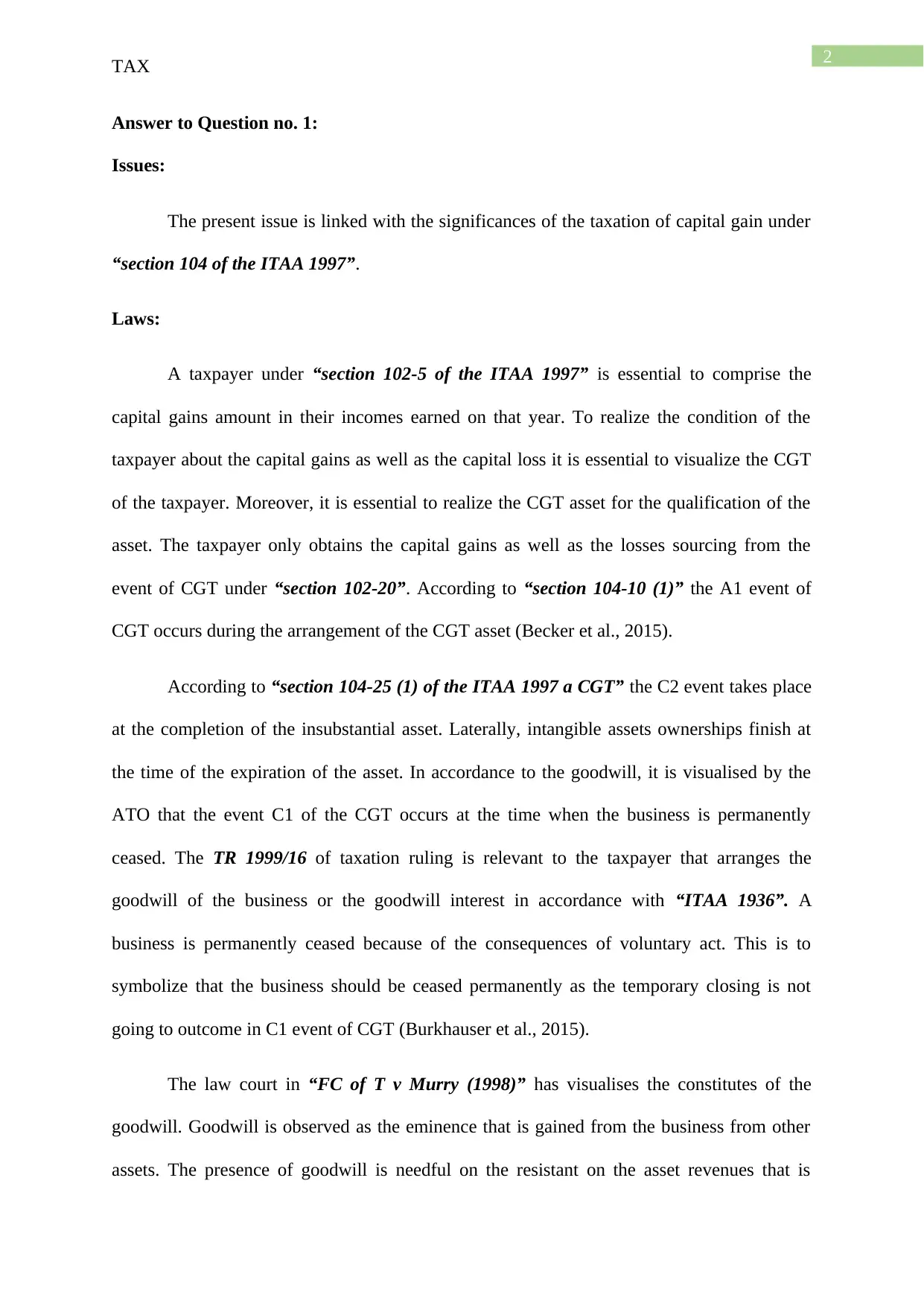
2
TAX
Answer to Question no. 1:
Issues:
The present issue is linked with the significances of the taxation of capital gain under
“section 104 of the ITAA 1997”.
Laws:
A taxpayer under “section 102-5 of the ITAA 1997” is essential to comprise the
capital gains amount in their incomes earned on that year. To realize the condition of the
taxpayer about the capital gains as well as the capital loss it is essential to visualize the CGT
of the taxpayer. Moreover, it is essential to realize the CGT asset for the qualification of the
asset. The taxpayer only obtains the capital gains as well as the losses sourcing from the
event of CGT under “section 102-20”. According to “section 104-10 (1)” the A1 event of
CGT occurs during the arrangement of the CGT asset (Becker et al., 2015).
According to “section 104-25 (1) of the ITAA 1997 a CGT” the C2 event takes place
at the completion of the insubstantial asset. Laterally, intangible assets ownerships finish at
the time of the expiration of the asset. In accordance to the goodwill, it is visualised by the
ATO that the event C1 of the CGT occurs at the time when the business is permanently
ceased. The TR 1999/16 of taxation ruling is relevant to the taxpayer that arranges the
goodwill of the business or the goodwill interest in accordance with “ITAA 1936”. A
business is permanently ceased because of the consequences of voluntary act. This is to
symbolize that the business should be ceased permanently as the temporary closing is not
going to outcome in C1 event of CGT (Burkhauser et al., 2015).
The law court in “FC of T v Murry (1998)” has visualises the constitutes of the
goodwill. Goodwill is observed as the eminence that is gained from the business from other
assets. The presence of goodwill is needful on the resistant on the asset revenues that is
TAX
Answer to Question no. 1:
Issues:
The present issue is linked with the significances of the taxation of capital gain under
“section 104 of the ITAA 1997”.
Laws:
A taxpayer under “section 102-5 of the ITAA 1997” is essential to comprise the
capital gains amount in their incomes earned on that year. To realize the condition of the
taxpayer about the capital gains as well as the capital loss it is essential to visualize the CGT
of the taxpayer. Moreover, it is essential to realize the CGT asset for the qualification of the
asset. The taxpayer only obtains the capital gains as well as the losses sourcing from the
event of CGT under “section 102-20”. According to “section 104-10 (1)” the A1 event of
CGT occurs during the arrangement of the CGT asset (Becker et al., 2015).
According to “section 104-25 (1) of the ITAA 1997 a CGT” the C2 event takes place
at the completion of the insubstantial asset. Laterally, intangible assets ownerships finish at
the time of the expiration of the asset. In accordance to the goodwill, it is visualised by the
ATO that the event C1 of the CGT occurs at the time when the business is permanently
ceased. The TR 1999/16 of taxation ruling is relevant to the taxpayer that arranges the
goodwill of the business or the goodwill interest in accordance with “ITAA 1936”. A
business is permanently ceased because of the consequences of voluntary act. This is to
symbolize that the business should be ceased permanently as the temporary closing is not
going to outcome in C1 event of CGT (Burkhauser et al., 2015).
The law court in “FC of T v Murry (1998)” has visualises the constitutes of the
goodwill. Goodwill is observed as the eminence that is gained from the business from other
assets. The presence of goodwill is needful on the resistant on the asset revenues that is
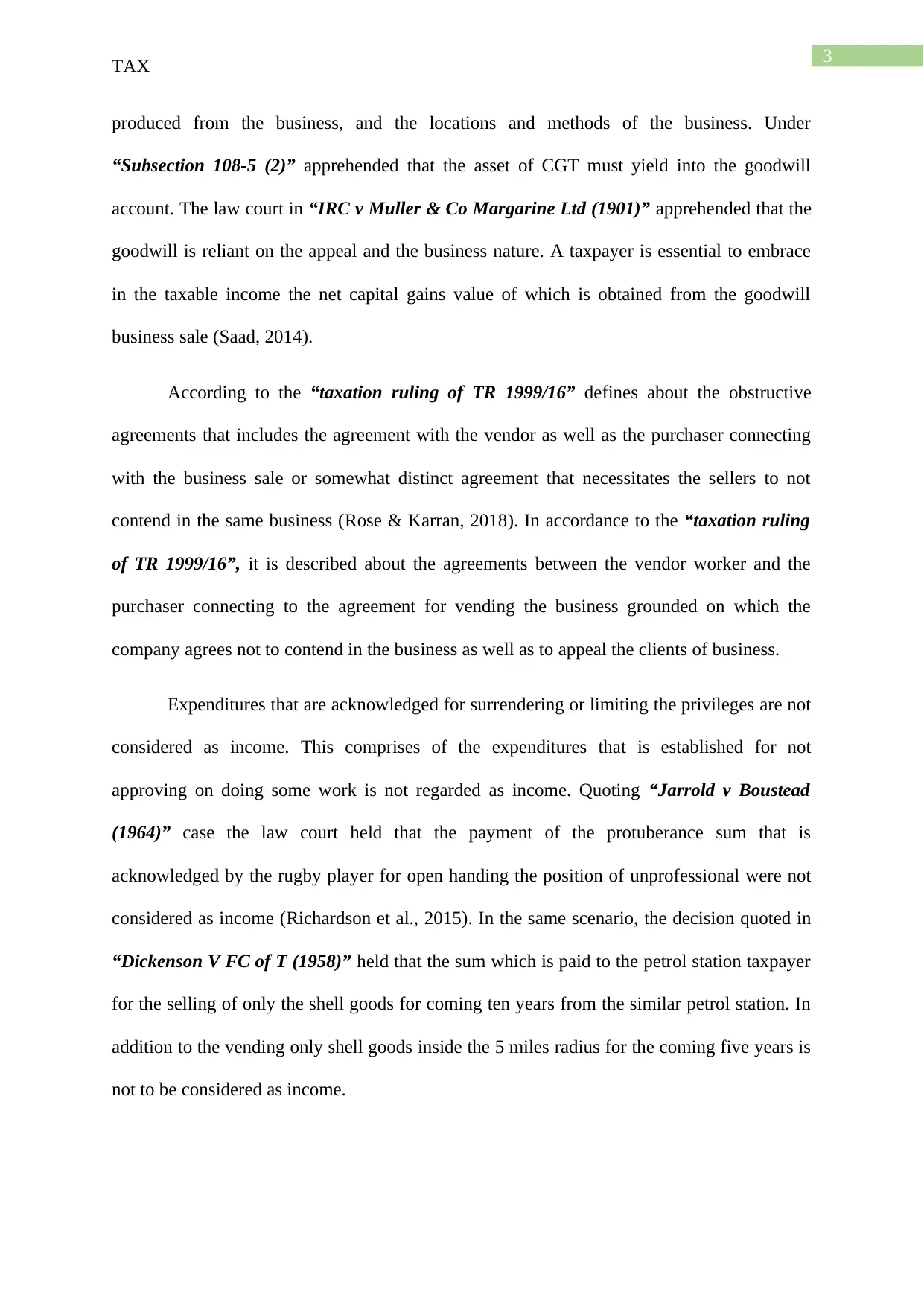
3
TAX
produced from the business, and the locations and methods of the business. Under
“Subsection 108-5 (2)” apprehended that the asset of CGT must yield into the goodwill
account. The law court in “IRC v Muller & Co Margarine Ltd (1901)” apprehended that the
goodwill is reliant on the appeal and the business nature. A taxpayer is essential to embrace
in the taxable income the net capital gains value of which is obtained from the goodwill
business sale (Saad, 2014).
According to the “taxation ruling of TR 1999/16” defines about the obstructive
agreements that includes the agreement with the vendor as well as the purchaser connecting
with the business sale or somewhat distinct agreement that necessitates the sellers to not
contend in the same business (Rose & Karran, 2018). In accordance to the “taxation ruling
of TR 1999/16”, it is described about the agreements between the vendor worker and the
purchaser connecting to the agreement for vending the business grounded on which the
company agrees not to contend in the business as well as to appeal the clients of business.
Expenditures that are acknowledged for surrendering or limiting the privileges are not
considered as income. This comprises of the expenditures that is established for not
approving on doing some work is not regarded as income. Quoting “Jarrold v Boustead
(1964)” case the law court held that the payment of the protuberance sum that is
acknowledged by the rugby player for open handing the position of unprofessional were not
considered as income (Richardson et al., 2015). In the same scenario, the decision quoted in
“Dickenson V FC of T (1958)” held that the sum which is paid to the petrol station taxpayer
for the selling of only the shell goods for coming ten years from the similar petrol station. In
addition to the vending only shell goods inside the 5 miles radius for the coming five years is
not to be considered as income.
TAX
produced from the business, and the locations and methods of the business. Under
“Subsection 108-5 (2)” apprehended that the asset of CGT must yield into the goodwill
account. The law court in “IRC v Muller & Co Margarine Ltd (1901)” apprehended that the
goodwill is reliant on the appeal and the business nature. A taxpayer is essential to embrace
in the taxable income the net capital gains value of which is obtained from the goodwill
business sale (Saad, 2014).
According to the “taxation ruling of TR 1999/16” defines about the obstructive
agreements that includes the agreement with the vendor as well as the purchaser connecting
with the business sale or somewhat distinct agreement that necessitates the sellers to not
contend in the same business (Rose & Karran, 2018). In accordance to the “taxation ruling
of TR 1999/16”, it is described about the agreements between the vendor worker and the
purchaser connecting to the agreement for vending the business grounded on which the
company agrees not to contend in the business as well as to appeal the clients of business.
Expenditures that are acknowledged for surrendering or limiting the privileges are not
considered as income. This comprises of the expenditures that is established for not
approving on doing some work is not regarded as income. Quoting “Jarrold v Boustead
(1964)” case the law court held that the payment of the protuberance sum that is
acknowledged by the rugby player for open handing the position of unprofessional were not
considered as income (Richardson et al., 2015). In the same scenario, the decision quoted in
“Dickenson V FC of T (1958)” held that the sum which is paid to the petrol station taxpayer
for the selling of only the shell goods for coming ten years from the similar petrol station. In
addition to the vending only shell goods inside the 5 miles radius for the coming five years is
not to be considered as income.
Secure Best Marks with AI Grader
Need help grading? Try our AI Grader for instant feedback on your assignments.
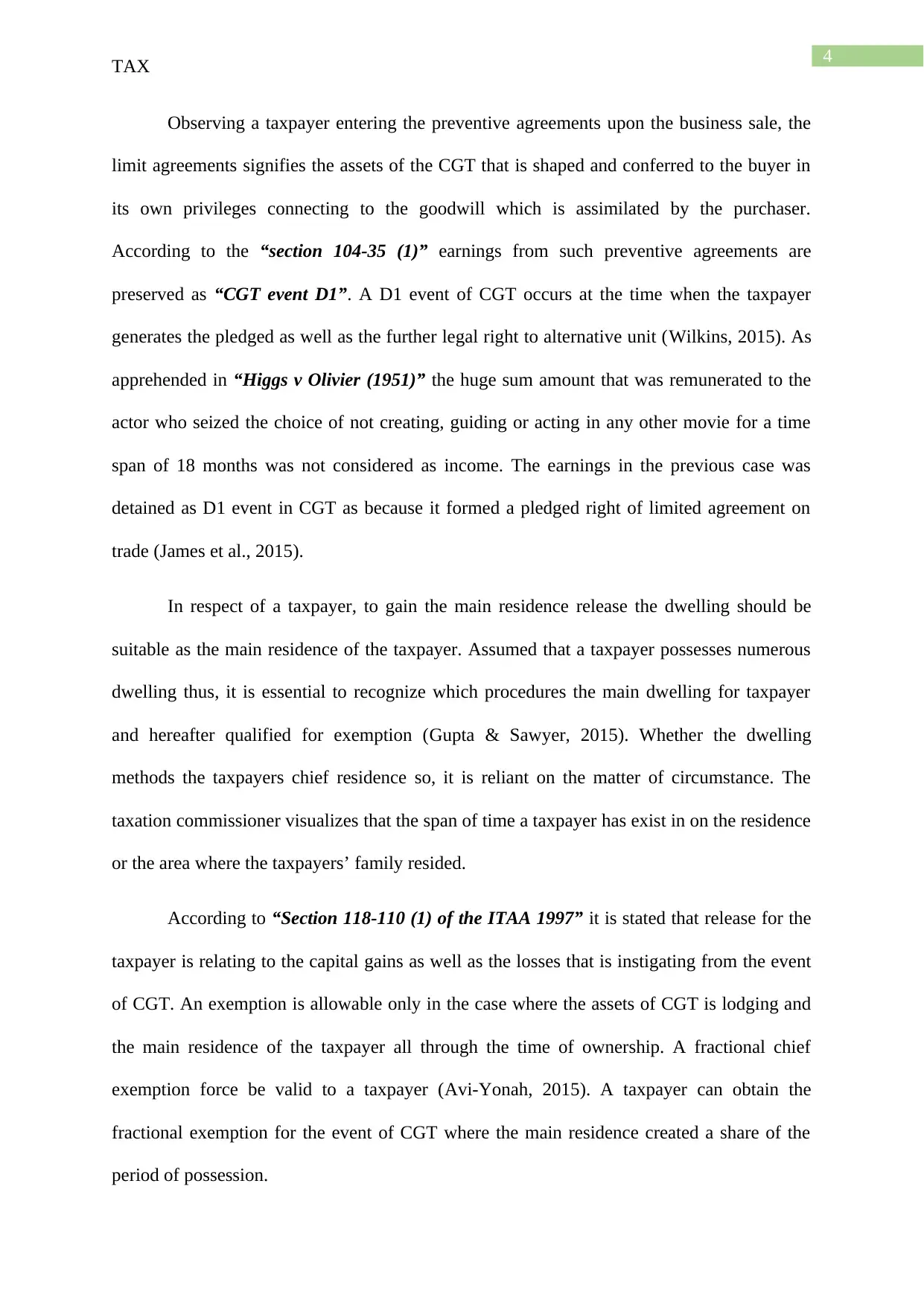
4
TAX
Observing a taxpayer entering the preventive agreements upon the business sale, the
limit agreements signifies the assets of the CGT that is shaped and conferred to the buyer in
its own privileges connecting to the goodwill which is assimilated by the purchaser.
According to the “section 104-35 (1)” earnings from such preventive agreements are
preserved as “CGT event D1”. A D1 event of CGT occurs at the time when the taxpayer
generates the pledged as well as the further legal right to alternative unit (Wilkins, 2015). As
apprehended in “Higgs v Olivier (1951)” the huge sum amount that was remunerated to the
actor who seized the choice of not creating, guiding or acting in any other movie for a time
span of 18 months was not considered as income. The earnings in the previous case was
detained as D1 event in CGT as because it formed a pledged right of limited agreement on
trade (James et al., 2015).
In respect of a taxpayer, to gain the main residence release the dwelling should be
suitable as the main residence of the taxpayer. Assumed that a taxpayer possesses numerous
dwelling thus, it is essential to recognize which procedures the main dwelling for taxpayer
and hereafter qualified for exemption (Gupta & Sawyer, 2015). Whether the dwelling
methods the taxpayers chief residence so, it is reliant on the matter of circumstance. The
taxation commissioner visualizes that the span of time a taxpayer has exist in on the residence
or the area where the taxpayers’ family resided.
According to “Section 118-110 (1) of the ITAA 1997” it is stated that release for the
taxpayer is relating to the capital gains as well as the losses that is instigating from the event
of CGT. An exemption is allowable only in the case where the assets of CGT is lodging and
the main residence of the taxpayer all through the time of ownership. A fractional chief
exemption force be valid to a taxpayer (Avi-Yonah, 2015). A taxpayer can obtain the
fractional exemption for the event of CGT where the main residence created a share of the
period of possession.
TAX
Observing a taxpayer entering the preventive agreements upon the business sale, the
limit agreements signifies the assets of the CGT that is shaped and conferred to the buyer in
its own privileges connecting to the goodwill which is assimilated by the purchaser.
According to the “section 104-35 (1)” earnings from such preventive agreements are
preserved as “CGT event D1”. A D1 event of CGT occurs at the time when the taxpayer
generates the pledged as well as the further legal right to alternative unit (Wilkins, 2015). As
apprehended in “Higgs v Olivier (1951)” the huge sum amount that was remunerated to the
actor who seized the choice of not creating, guiding or acting in any other movie for a time
span of 18 months was not considered as income. The earnings in the previous case was
detained as D1 event in CGT as because it formed a pledged right of limited agreement on
trade (James et al., 2015).
In respect of a taxpayer, to gain the main residence release the dwelling should be
suitable as the main residence of the taxpayer. Assumed that a taxpayer possesses numerous
dwelling thus, it is essential to recognize which procedures the main dwelling for taxpayer
and hereafter qualified for exemption (Gupta & Sawyer, 2015). Whether the dwelling
methods the taxpayers chief residence so, it is reliant on the matter of circumstance. The
taxation commissioner visualizes that the span of time a taxpayer has exist in on the residence
or the area where the taxpayers’ family resided.
According to “Section 118-110 (1) of the ITAA 1997” it is stated that release for the
taxpayer is relating to the capital gains as well as the losses that is instigating from the event
of CGT. An exemption is allowable only in the case where the assets of CGT is lodging and
the main residence of the taxpayer all through the time of ownership. A fractional chief
exemption force be valid to a taxpayer (Avi-Yonah, 2015). A taxpayer can obtain the
fractional exemption for the event of CGT where the main residence created a share of the
period of possession.
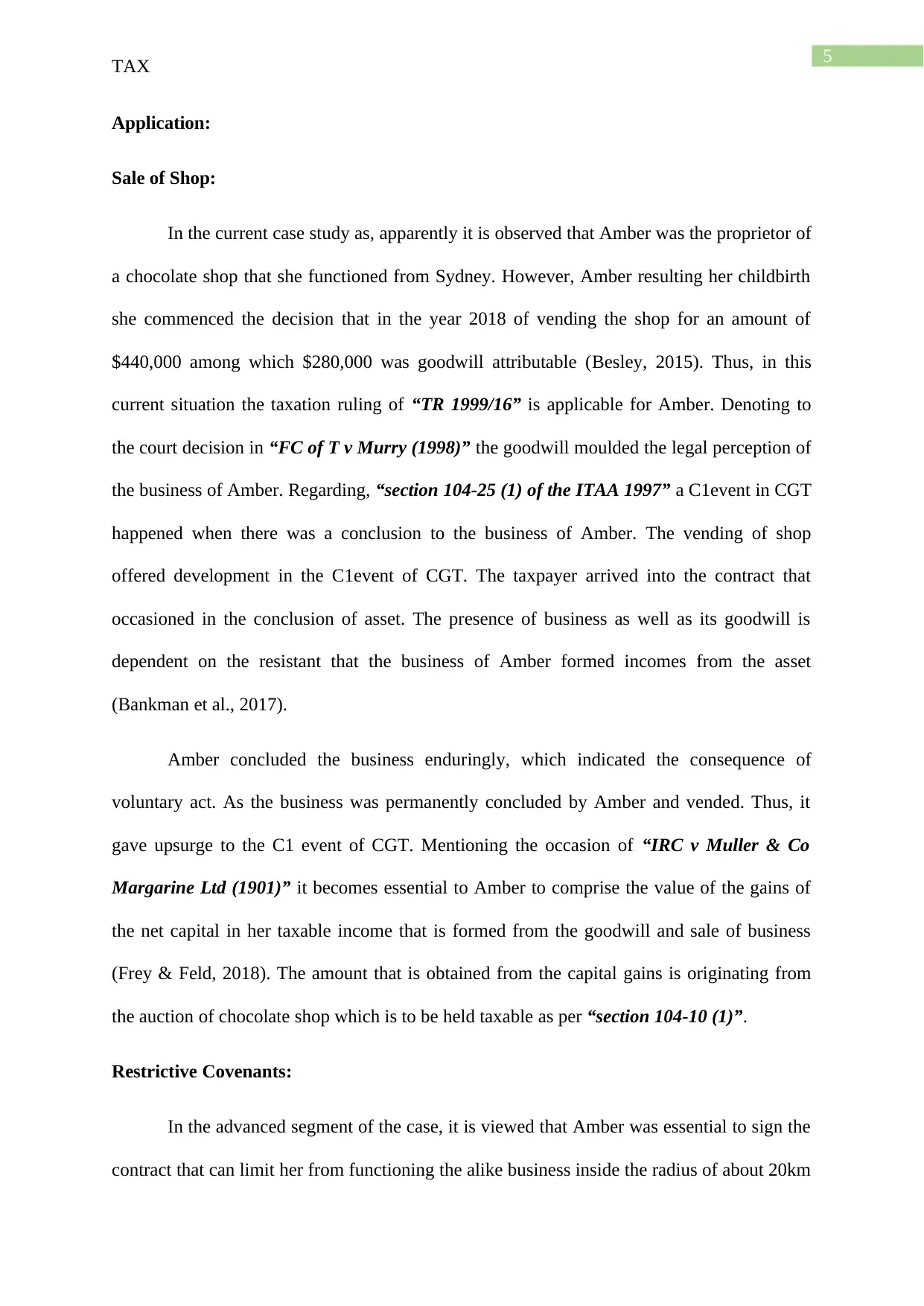
5
TAX
Application:
Sale of Shop:
In the current case study as, apparently it is observed that Amber was the proprietor of
a chocolate shop that she functioned from Sydney. However, Amber resulting her childbirth
she commenced the decision that in the year 2018 of vending the shop for an amount of
$440,000 among which $280,000 was goodwill attributable (Besley, 2015). Thus, in this
current situation the taxation ruling of “TR 1999/16” is applicable for Amber. Denoting to
the court decision in “FC of T v Murry (1998)” the goodwill moulded the legal perception of
the business of Amber. Regarding, “section 104-25 (1) of the ITAA 1997” a C1event in CGT
happened when there was a conclusion to the business of Amber. The vending of shop
offered development in the C1event of CGT. The taxpayer arrived into the contract that
occasioned in the conclusion of asset. The presence of business as well as its goodwill is
dependent on the resistant that the business of Amber formed incomes from the asset
(Bankman et al., 2017).
Amber concluded the business enduringly, which indicated the consequence of
voluntary act. As the business was permanently concluded by Amber and vended. Thus, it
gave upsurge to the C1 event of CGT. Mentioning the occasion of “IRC v Muller & Co
Margarine Ltd (1901)” it becomes essential to Amber to comprise the value of the gains of
the net capital in her taxable income that is formed from the goodwill and sale of business
(Frey & Feld, 2018). The amount that is obtained from the capital gains is originating from
the auction of chocolate shop which is to be held taxable as per “section 104-10 (1)”.
Restrictive Covenants:
In the advanced segment of the case, it is viewed that Amber was essential to sign the
contract that can limit her from functioning the alike business inside the radius of about 20km
TAX
Application:
Sale of Shop:
In the current case study as, apparently it is observed that Amber was the proprietor of
a chocolate shop that she functioned from Sydney. However, Amber resulting her childbirth
she commenced the decision that in the year 2018 of vending the shop for an amount of
$440,000 among which $280,000 was goodwill attributable (Besley, 2015). Thus, in this
current situation the taxation ruling of “TR 1999/16” is applicable for Amber. Denoting to
the court decision in “FC of T v Murry (1998)” the goodwill moulded the legal perception of
the business of Amber. Regarding, “section 104-25 (1) of the ITAA 1997” a C1event in CGT
happened when there was a conclusion to the business of Amber. The vending of shop
offered development in the C1event of CGT. The taxpayer arrived into the contract that
occasioned in the conclusion of asset. The presence of business as well as its goodwill is
dependent on the resistant that the business of Amber formed incomes from the asset
(Bankman et al., 2017).
Amber concluded the business enduringly, which indicated the consequence of
voluntary act. As the business was permanently concluded by Amber and vended. Thus, it
gave upsurge to the C1 event of CGT. Mentioning the occasion of “IRC v Muller & Co
Margarine Ltd (1901)” it becomes essential to Amber to comprise the value of the gains of
the net capital in her taxable income that is formed from the goodwill and sale of business
(Frey & Feld, 2018). The amount that is obtained from the capital gains is originating from
the auction of chocolate shop which is to be held taxable as per “section 104-10 (1)”.
Restrictive Covenants:
In the advanced segment of the case, it is viewed that Amber was essential to sign the
contract that can limit her from functioning the alike business inside the radius of about 20km
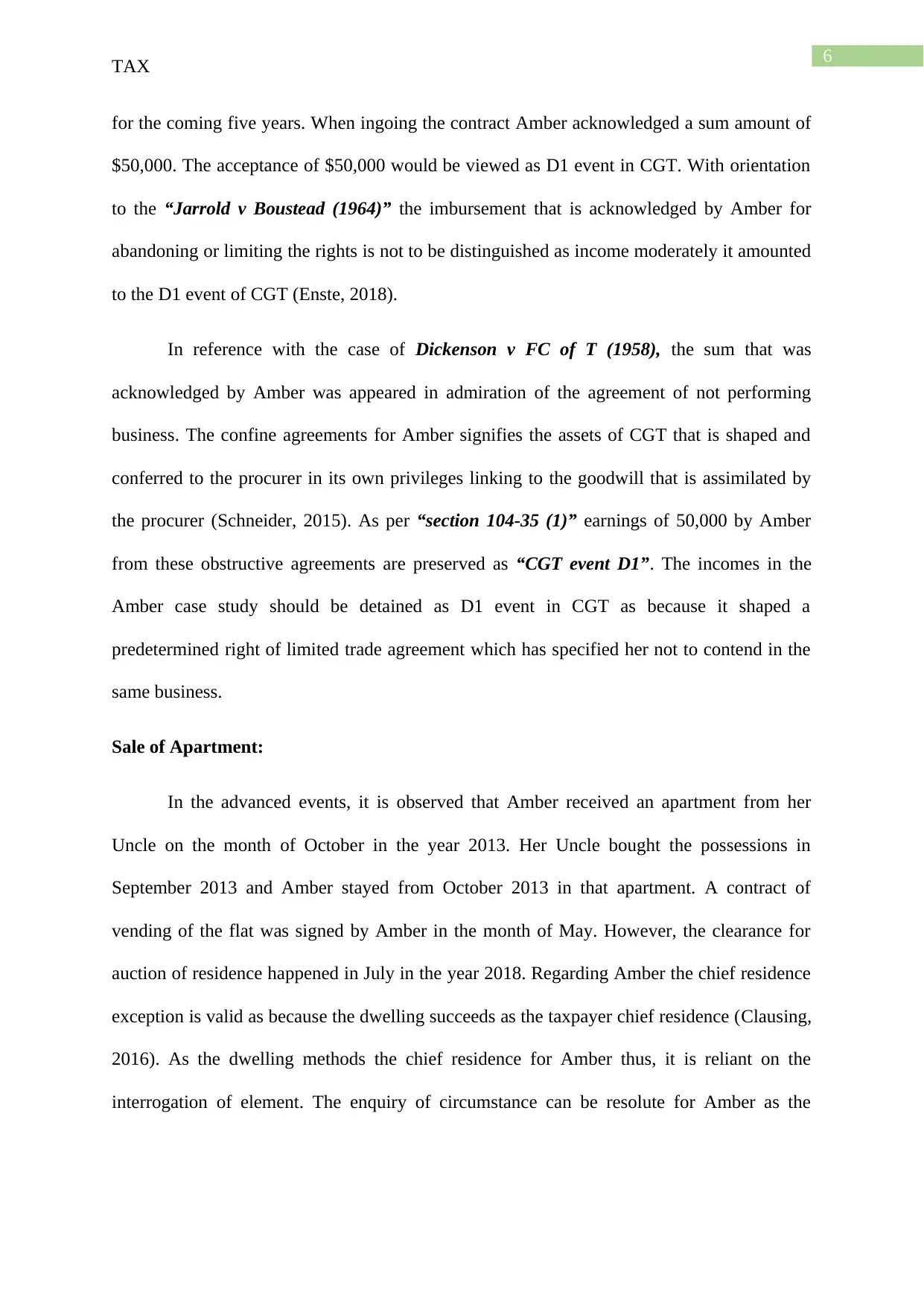
6
TAX
for the coming five years. When ingoing the contract Amber acknowledged a sum amount of
$50,000. The acceptance of $50,000 would be viewed as D1 event in CGT. With orientation
to the “Jarrold v Boustead (1964)” the imbursement that is acknowledged by Amber for
abandoning or limiting the rights is not to be distinguished as income moderately it amounted
to the D1 event of CGT (Enste, 2018).
In reference with the case of Dickenson v FC of T (1958), the sum that was
acknowledged by Amber was appeared in admiration of the agreement of not performing
business. The confine agreements for Amber signifies the assets of CGT that is shaped and
conferred to the procurer in its own privileges linking to the goodwill that is assimilated by
the procurer (Schneider, 2015). As per “section 104-35 (1)” earnings of 50,000 by Amber
from these obstructive agreements are preserved as “CGT event D1”. The incomes in the
Amber case study should be detained as D1 event in CGT as because it shaped a
predetermined right of limited trade agreement which has specified her not to contend in the
same business.
Sale of Apartment:
In the advanced events, it is observed that Amber received an apartment from her
Uncle on the month of October in the year 2013. Her Uncle bought the possessions in
September 2013 and Amber stayed from October 2013 in that apartment. A contract of
vending of the flat was signed by Amber in the month of May. However, the clearance for
auction of residence happened in July in the year 2018. Regarding Amber the chief residence
exception is valid as because the dwelling succeeds as the taxpayer chief residence (Clausing,
2016). As the dwelling methods the chief residence for Amber thus, it is reliant on the
interrogation of element. The enquiry of circumstance can be resolute for Amber as the
TAX
for the coming five years. When ingoing the contract Amber acknowledged a sum amount of
$50,000. The acceptance of $50,000 would be viewed as D1 event in CGT. With orientation
to the “Jarrold v Boustead (1964)” the imbursement that is acknowledged by Amber for
abandoning or limiting the rights is not to be distinguished as income moderately it amounted
to the D1 event of CGT (Enste, 2018).
In reference with the case of Dickenson v FC of T (1958), the sum that was
acknowledged by Amber was appeared in admiration of the agreement of not performing
business. The confine agreements for Amber signifies the assets of CGT that is shaped and
conferred to the procurer in its own privileges linking to the goodwill that is assimilated by
the procurer (Schneider, 2015). As per “section 104-35 (1)” earnings of 50,000 by Amber
from these obstructive agreements are preserved as “CGT event D1”. The incomes in the
Amber case study should be detained as D1 event in CGT as because it shaped a
predetermined right of limited trade agreement which has specified her not to contend in the
same business.
Sale of Apartment:
In the advanced events, it is observed that Amber received an apartment from her
Uncle on the month of October in the year 2013. Her Uncle bought the possessions in
September 2013 and Amber stayed from October 2013 in that apartment. A contract of
vending of the flat was signed by Amber in the month of May. However, the clearance for
auction of residence happened in July in the year 2018. Regarding Amber the chief residence
exception is valid as because the dwelling succeeds as the taxpayer chief residence (Clausing,
2016). As the dwelling methods the chief residence for Amber thus, it is reliant on the
interrogation of element. The enquiry of circumstance can be resolute for Amber as the
Paraphrase This Document
Need a fresh take? Get an instant paraphrase of this document with our AI Paraphraser
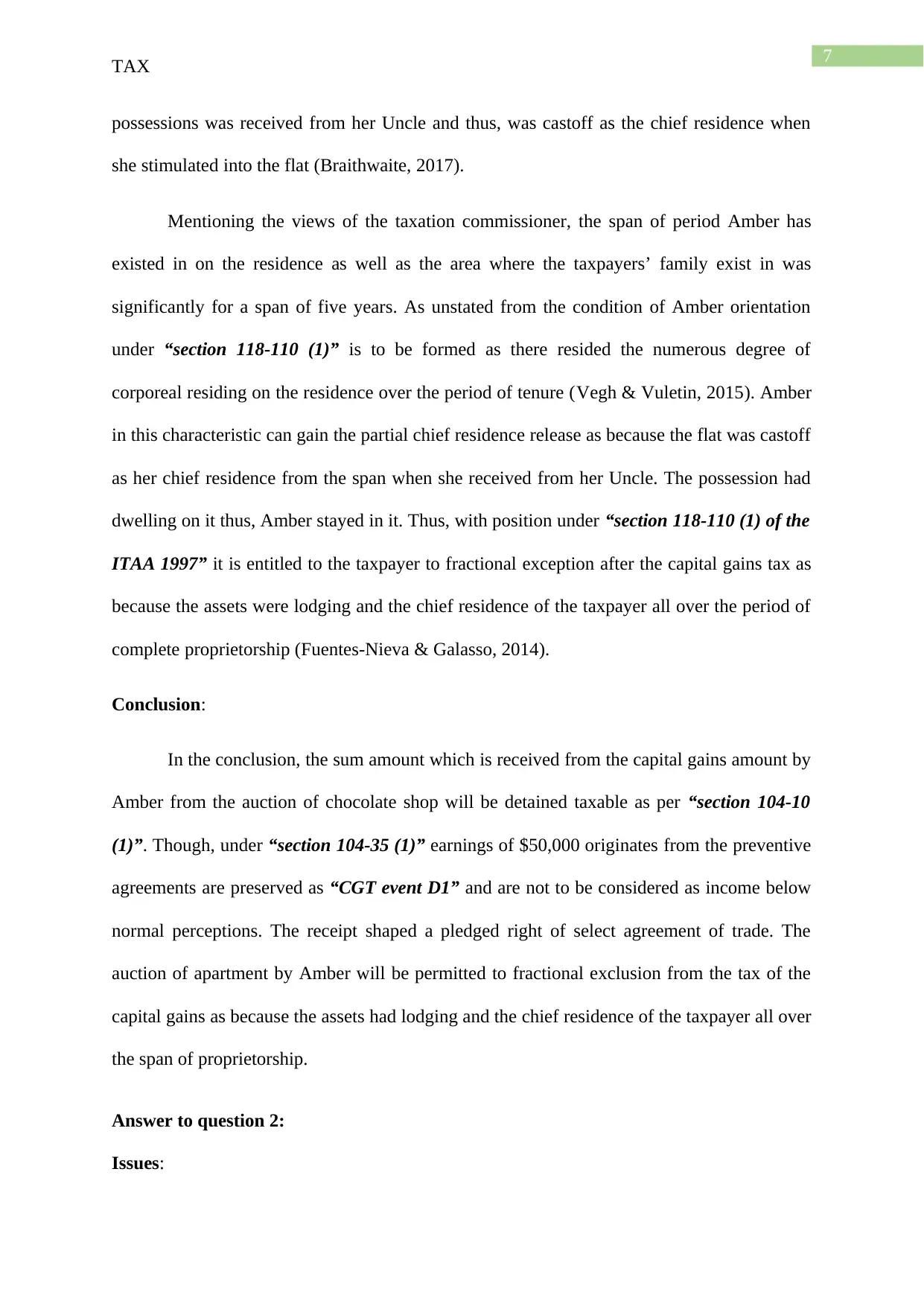
7
TAX
possessions was received from her Uncle and thus, was castoff as the chief residence when
she stimulated into the flat (Braithwaite, 2017).
Mentioning the views of the taxation commissioner, the span of period Amber has
existed in on the residence as well as the area where the taxpayers’ family exist in was
significantly for a span of five years. As unstated from the condition of Amber orientation
under “section 118-110 (1)” is to be formed as there resided the numerous degree of
corporeal residing on the residence over the period of tenure (Vegh & Vuletin, 2015). Amber
in this characteristic can gain the partial chief residence release as because the flat was castoff
as her chief residence from the span when she received from her Uncle. The possession had
dwelling on it thus, Amber stayed in it. Thus, with position under “section 118-110 (1) of the
ITAA 1997” it is entitled to the taxpayer to fractional exception after the capital gains tax as
because the assets were lodging and the chief residence of the taxpayer all over the period of
complete proprietorship (Fuentes-Nieva & Galasso, 2014).
Conclusion:
In the conclusion, the sum amount which is received from the capital gains amount by
Amber from the auction of chocolate shop will be detained taxable as per “section 104-10
(1)”. Though, under “section 104-35 (1)” earnings of $50,000 originates from the preventive
agreements are preserved as “CGT event D1” and are not to be considered as income below
normal perceptions. The receipt shaped a pledged right of select agreement of trade. The
auction of apartment by Amber will be permitted to fractional exclusion from the tax of the
capital gains as because the assets had lodging and the chief residence of the taxpayer all over
the span of proprietorship.
Answer to question 2:
Issues:
TAX
possessions was received from her Uncle and thus, was castoff as the chief residence when
she stimulated into the flat (Braithwaite, 2017).
Mentioning the views of the taxation commissioner, the span of period Amber has
existed in on the residence as well as the area where the taxpayers’ family exist in was
significantly for a span of five years. As unstated from the condition of Amber orientation
under “section 118-110 (1)” is to be formed as there resided the numerous degree of
corporeal residing on the residence over the period of tenure (Vegh & Vuletin, 2015). Amber
in this characteristic can gain the partial chief residence release as because the flat was castoff
as her chief residence from the span when she received from her Uncle. The possession had
dwelling on it thus, Amber stayed in it. Thus, with position under “section 118-110 (1) of the
ITAA 1997” it is entitled to the taxpayer to fractional exception after the capital gains tax as
because the assets were lodging and the chief residence of the taxpayer all over the period of
complete proprietorship (Fuentes-Nieva & Galasso, 2014).
Conclusion:
In the conclusion, the sum amount which is received from the capital gains amount by
Amber from the auction of chocolate shop will be detained taxable as per “section 104-10
(1)”. Though, under “section 104-35 (1)” earnings of $50,000 originates from the preventive
agreements are preserved as “CGT event D1” and are not to be considered as income below
normal perceptions. The receipt shaped a pledged right of select agreement of trade. The
auction of apartment by Amber will be permitted to fractional exclusion from the tax of the
capital gains as because the assets had lodging and the chief residence of the taxpayer all over
the span of proprietorship.
Answer to question 2:
Issues:
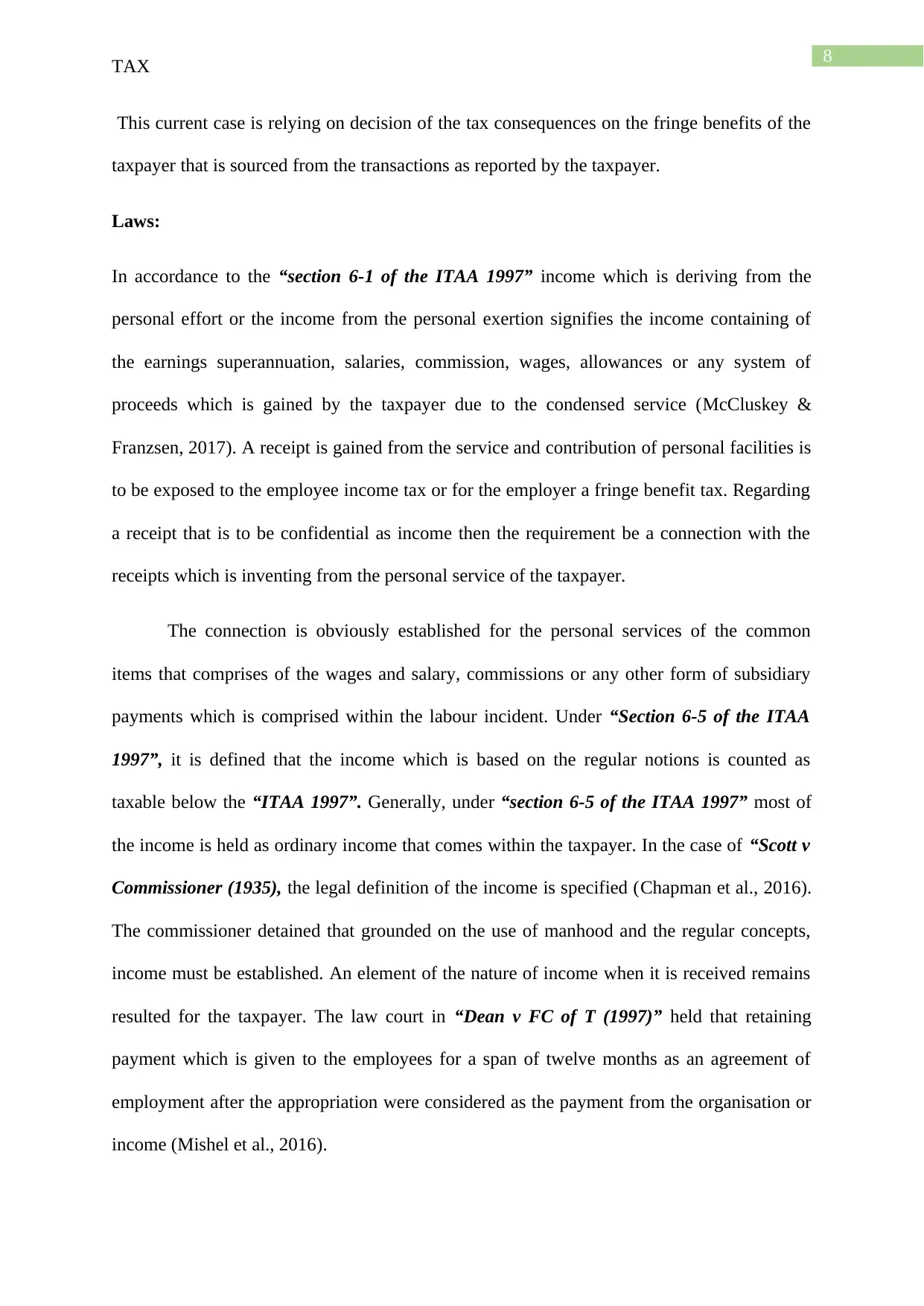
8
TAX
This current case is relying on decision of the tax consequences on the fringe benefits of the
taxpayer that is sourced from the transactions as reported by the taxpayer.
Laws:
In accordance to the “section 6-1 of the ITAA 1997” income which is deriving from the
personal effort or the income from the personal exertion signifies the income containing of
the earnings superannuation, salaries, commission, wages, allowances or any system of
proceeds which is gained by the taxpayer due to the condensed service (McCluskey &
Franzsen, 2017). A receipt is gained from the service and contribution of personal facilities is
to be exposed to the employee income tax or for the employer a fringe benefit tax. Regarding
a receipt that is to be confidential as income then the requirement be a connection with the
receipts which is inventing from the personal service of the taxpayer.
The connection is obviously established for the personal services of the common
items that comprises of the wages and salary, commissions or any other form of subsidiary
payments which is comprised within the labour incident. Under “Section 6-5 of the ITAA
1997”, it is defined that the income which is based on the regular notions is counted as
taxable below the “ITAA 1997”. Generally, under “section 6-5 of the ITAA 1997” most of
the income is held as ordinary income that comes within the taxpayer. In the case of “Scott v
Commissioner (1935), the legal definition of the income is specified (Chapman et al., 2016).
The commissioner detained that grounded on the use of manhood and the regular concepts,
income must be established. An element of the nature of income when it is received remains
resulted for the taxpayer. The law court in “Dean v FC of T (1997)” held that retaining
payment which is given to the employees for a span of twelve months as an agreement of
employment after the appropriation were considered as the payment from the organisation or
income (Mishel et al., 2016).
TAX
This current case is relying on decision of the tax consequences on the fringe benefits of the
taxpayer that is sourced from the transactions as reported by the taxpayer.
Laws:
In accordance to the “section 6-1 of the ITAA 1997” income which is deriving from the
personal effort or the income from the personal exertion signifies the income containing of
the earnings superannuation, salaries, commission, wages, allowances or any system of
proceeds which is gained by the taxpayer due to the condensed service (McCluskey &
Franzsen, 2017). A receipt is gained from the service and contribution of personal facilities is
to be exposed to the employee income tax or for the employer a fringe benefit tax. Regarding
a receipt that is to be confidential as income then the requirement be a connection with the
receipts which is inventing from the personal service of the taxpayer.
The connection is obviously established for the personal services of the common
items that comprises of the wages and salary, commissions or any other form of subsidiary
payments which is comprised within the labour incident. Under “Section 6-5 of the ITAA
1997”, it is defined that the income which is based on the regular notions is counted as
taxable below the “ITAA 1997”. Generally, under “section 6-5 of the ITAA 1997” most of
the income is held as ordinary income that comes within the taxpayer. In the case of “Scott v
Commissioner (1935), the legal definition of the income is specified (Chapman et al., 2016).
The commissioner detained that grounded on the use of manhood and the regular concepts,
income must be established. An element of the nature of income when it is received remains
resulted for the taxpayer. The law court in “Dean v FC of T (1997)” held that retaining
payment which is given to the employees for a span of twelve months as an agreement of
employment after the appropriation were considered as the payment from the organisation or
income (Mishel et al., 2016).
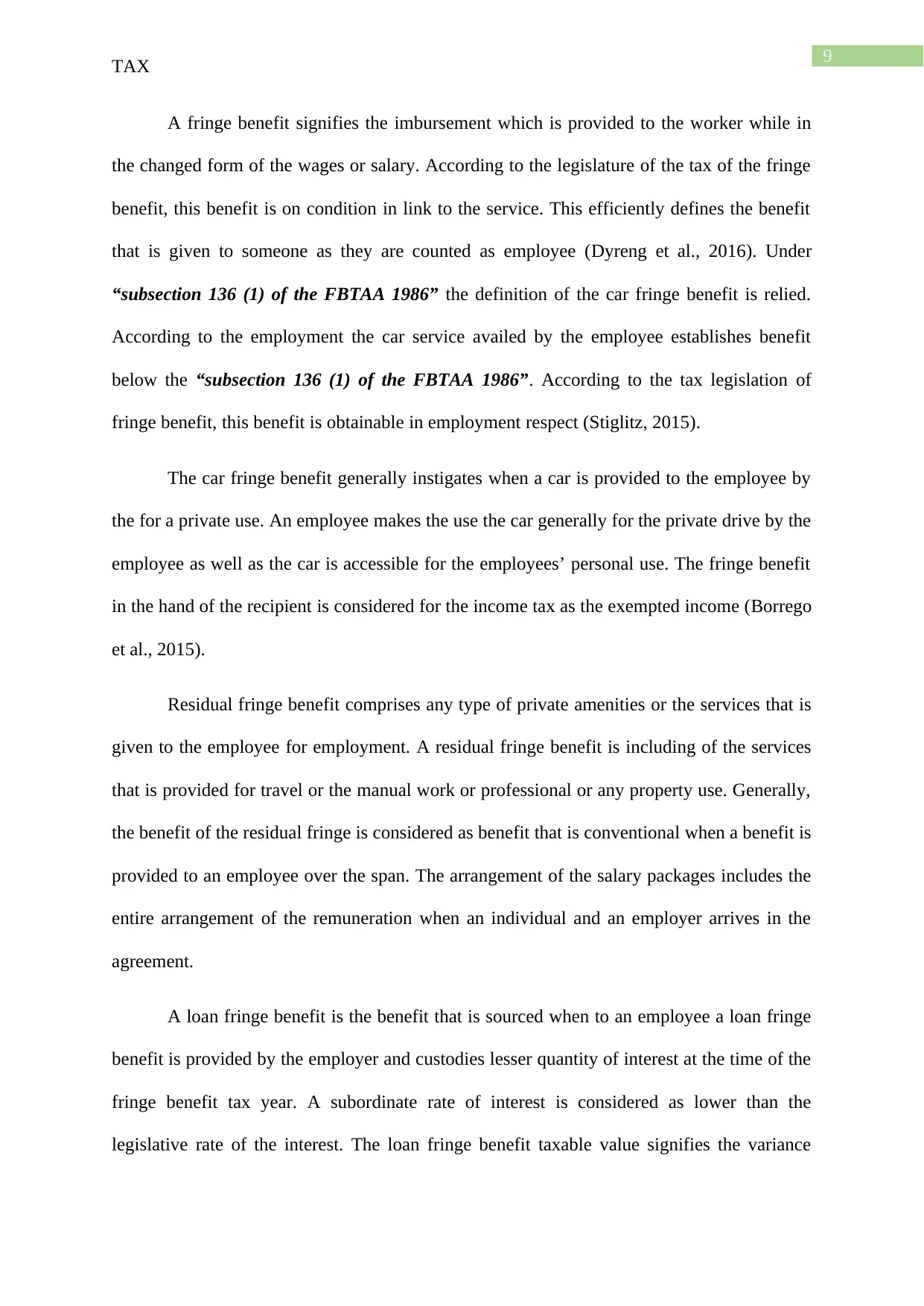
9
TAX
A fringe benefit signifies the imbursement which is provided to the worker while in
the changed form of the wages or salary. According to the legislature of the tax of the fringe
benefit, this benefit is on condition in link to the service. This efficiently defines the benefit
that is given to someone as they are counted as employee (Dyreng et al., 2016). Under
“subsection 136 (1) of the FBTAA 1986” the definition of the car fringe benefit is relied.
According to the employment the car service availed by the employee establishes benefit
below the “subsection 136 (1) of the FBTAA 1986”. According to the tax legislation of
fringe benefit, this benefit is obtainable in employment respect (Stiglitz, 2015).
The car fringe benefit generally instigates when a car is provided to the employee by
the for a private use. An employee makes the use the car generally for the private drive by the
employee as well as the car is accessible for the employees’ personal use. The fringe benefit
in the hand of the recipient is considered for the income tax as the exempted income (Borrego
et al., 2015).
Residual fringe benefit comprises any type of private amenities or the services that is
given to the employee for employment. A residual fringe benefit is including of the services
that is provided for travel or the manual work or professional or any property use. Generally,
the benefit of the residual fringe is considered as benefit that is conventional when a benefit is
provided to an employee over the span. The arrangement of the salary packages includes the
entire arrangement of the remuneration when an individual and an employer arrives in the
agreement.
A loan fringe benefit is the benefit that is sourced when to an employee a loan fringe
benefit is provided by the employer and custodies lesser quantity of interest at the time of the
fringe benefit tax year. A subordinate rate of interest is considered as lower than the
legislative rate of the interest. The loan fringe benefit taxable value signifies the variance
TAX
A fringe benefit signifies the imbursement which is provided to the worker while in
the changed form of the wages or salary. According to the legislature of the tax of the fringe
benefit, this benefit is on condition in link to the service. This efficiently defines the benefit
that is given to someone as they are counted as employee (Dyreng et al., 2016). Under
“subsection 136 (1) of the FBTAA 1986” the definition of the car fringe benefit is relied.
According to the employment the car service availed by the employee establishes benefit
below the “subsection 136 (1) of the FBTAA 1986”. According to the tax legislation of
fringe benefit, this benefit is obtainable in employment respect (Stiglitz, 2015).
The car fringe benefit generally instigates when a car is provided to the employee by
the for a private use. An employee makes the use the car generally for the private drive by the
employee as well as the car is accessible for the employees’ personal use. The fringe benefit
in the hand of the recipient is considered for the income tax as the exempted income (Borrego
et al., 2015).
Residual fringe benefit comprises any type of private amenities or the services that is
given to the employee for employment. A residual fringe benefit is including of the services
that is provided for travel or the manual work or professional or any property use. Generally,
the benefit of the residual fringe is considered as benefit that is conventional when a benefit is
provided to an employee over the span. The arrangement of the salary packages includes the
entire arrangement of the remuneration when an individual and an employer arrives in the
agreement.
A loan fringe benefit is the benefit that is sourced when to an employee a loan fringe
benefit is provided by the employer and custodies lesser quantity of interest at the time of the
fringe benefit tax year. A subordinate rate of interest is considered as lower than the
legislative rate of the interest. The loan fringe benefit taxable value signifies the variance
Secure Best Marks with AI Grader
Need help grading? Try our AI Grader for instant feedback on your assignments.
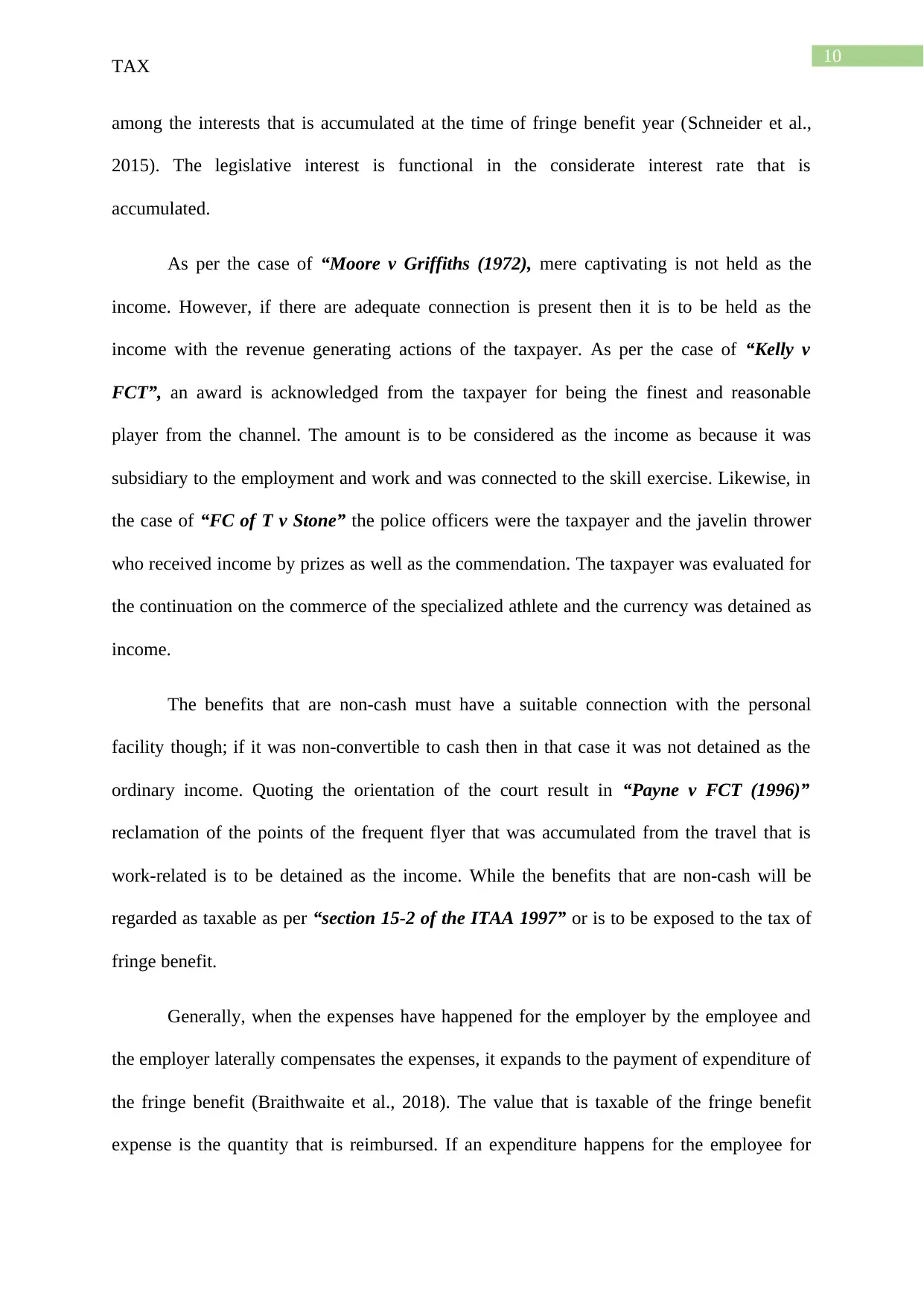
10
TAX
among the interests that is accumulated at the time of fringe benefit year (Schneider et al.,
2015). The legislative interest is functional in the considerate interest rate that is
accumulated.
As per the case of “Moore v Griffiths (1972), mere captivating is not held as the
income. However, if there are adequate connection is present then it is to be held as the
income with the revenue generating actions of the taxpayer. As per the case of “Kelly v
FCT”, an award is acknowledged from the taxpayer for being the finest and reasonable
player from the channel. The amount is to be considered as the income as because it was
subsidiary to the employment and work and was connected to the skill exercise. Likewise, in
the case of “FC of T v Stone” the police officers were the taxpayer and the javelin thrower
who received income by prizes as well as the commendation. The taxpayer was evaluated for
the continuation on the commerce of the specialized athlete and the currency was detained as
income.
The benefits that are non-cash must have a suitable connection with the personal
facility though; if it was non-convertible to cash then in that case it was not detained as the
ordinary income. Quoting the orientation of the court result in “Payne v FCT (1996)”
reclamation of the points of the frequent flyer that was accumulated from the travel that is
work-related is to be detained as the income. While the benefits that are non-cash will be
regarded as taxable as per “section 15-2 of the ITAA 1997” or is to be exposed to the tax of
fringe benefit.
Generally, when the expenses have happened for the employer by the employee and
the employer laterally compensates the expenses, it expands to the payment of expenditure of
the fringe benefit (Braithwaite et al., 2018). The value that is taxable of the fringe benefit
expense is the quantity that is reimbursed. If an expenditure happens for the employee for
TAX
among the interests that is accumulated at the time of fringe benefit year (Schneider et al.,
2015). The legislative interest is functional in the considerate interest rate that is
accumulated.
As per the case of “Moore v Griffiths (1972), mere captivating is not held as the
income. However, if there are adequate connection is present then it is to be held as the
income with the revenue generating actions of the taxpayer. As per the case of “Kelly v
FCT”, an award is acknowledged from the taxpayer for being the finest and reasonable
player from the channel. The amount is to be considered as the income as because it was
subsidiary to the employment and work and was connected to the skill exercise. Likewise, in
the case of “FC of T v Stone” the police officers were the taxpayer and the javelin thrower
who received income by prizes as well as the commendation. The taxpayer was evaluated for
the continuation on the commerce of the specialized athlete and the currency was detained as
income.
The benefits that are non-cash must have a suitable connection with the personal
facility though; if it was non-convertible to cash then in that case it was not detained as the
ordinary income. Quoting the orientation of the court result in “Payne v FCT (1996)”
reclamation of the points of the frequent flyer that was accumulated from the travel that is
work-related is to be detained as the income. While the benefits that are non-cash will be
regarded as taxable as per “section 15-2 of the ITAA 1997” or is to be exposed to the tax of
fringe benefit.
Generally, when the expenses have happened for the employer by the employee and
the employer laterally compensates the expenses, it expands to the payment of expenditure of
the fringe benefit (Braithwaite et al., 2018). The value that is taxable of the fringe benefit
expense is the quantity that is reimbursed. If an expenditure happens for the employee for

11
TAX
performing the duties that are related with employment, the expenditure then for income tax
it is to be completely held deductible. Generally, where the employee has experienced the
expenditures for the employer though the payment of those benefit consequences in the
expansion of fringe benefit.
Application:
Salary Income:
The current case study is grounded on defining the tax consequences of the fringe
benefit for Jamie who functioned as the agent for a real estate company that is the Houses R
Us. As the segment of the contract of employment, Jamie was given with the salary of
amounting $50,000. Under “section 6-1 of the ITAA 1997”, the receiving of salary signifies
income derives from the personal effort. The receipt amounting of $50,000 that is received
from the employment signifies the income from the services and is imperilled to income tax.
According to “section 6-5 of the ITAA 1997”, the wages under the regular concepts would
be considered as ordinary income. Raising the case of “Scott v Commissioner (1935)”
receiving of salary grounded on the ordinary perceptions is to be held as income of the
“ITAA 1997”. Mentioning about the case of “Dean v FC of T (1997)” the wages that is
received from the employment is to be held as remuneration (Braithwaite et al., 2018).
Car Fringe Benefits:
Laterally in another case, it is observed that Jamie by his employer is provided with
the car for the private use as well as for work. By the service car usage by Jamie establishes
benefit as per “subsection 136 (1) of the FBTAA 1986”. The car fringe benefit characterizes
the benefit that is presented for employment. The car usage characterizes the privately by
Jamie together within the working hours as well as outside of it at the weekends.
TAX
performing the duties that are related with employment, the expenditure then for income tax
it is to be completely held deductible. Generally, where the employee has experienced the
expenditures for the employer though the payment of those benefit consequences in the
expansion of fringe benefit.
Application:
Salary Income:
The current case study is grounded on defining the tax consequences of the fringe
benefit for Jamie who functioned as the agent for a real estate company that is the Houses R
Us. As the segment of the contract of employment, Jamie was given with the salary of
amounting $50,000. Under “section 6-1 of the ITAA 1997”, the receiving of salary signifies
income derives from the personal effort. The receipt amounting of $50,000 that is received
from the employment signifies the income from the services and is imperilled to income tax.
According to “section 6-5 of the ITAA 1997”, the wages under the regular concepts would
be considered as ordinary income. Raising the case of “Scott v Commissioner (1935)”
receiving of salary grounded on the ordinary perceptions is to be held as income of the
“ITAA 1997”. Mentioning about the case of “Dean v FC of T (1997)” the wages that is
received from the employment is to be held as remuneration (Braithwaite et al., 2018).
Car Fringe Benefits:
Laterally in another case, it is observed that Jamie by his employer is provided with
the car for the private use as well as for work. By the service car usage by Jamie establishes
benefit as per “subsection 136 (1) of the FBTAA 1986”. The car fringe benefit characterizes
the benefit that is presented for employment. The car usage characterizes the privately by
Jamie together within the working hours as well as outside of it at the weekends.
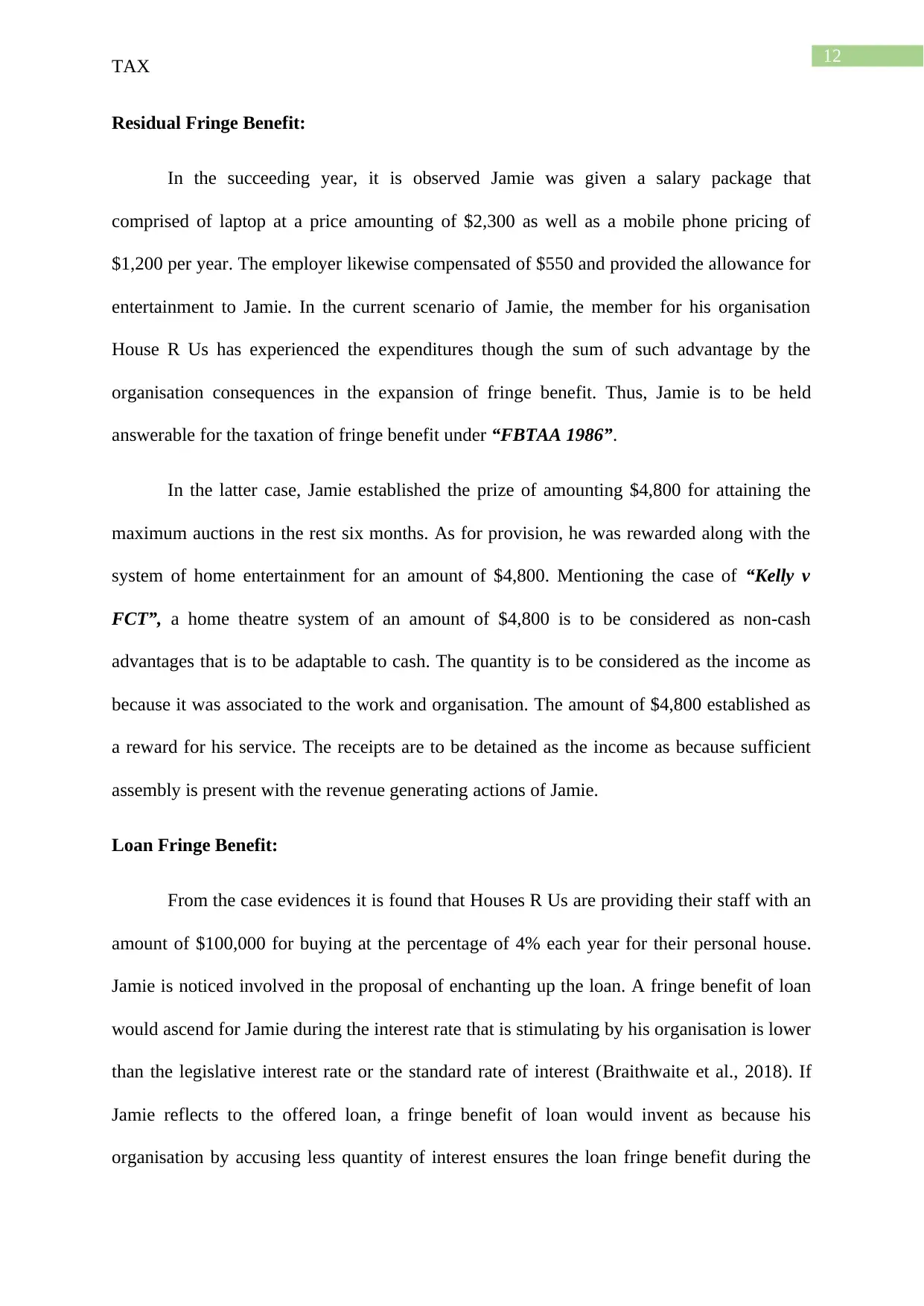
12
TAX
Residual Fringe Benefit:
In the succeeding year, it is observed Jamie was given a salary package that
comprised of laptop at a price amounting of $2,300 as well as a mobile phone pricing of
$1,200 per year. The employer likewise compensated of $550 and provided the allowance for
entertainment to Jamie. In the current scenario of Jamie, the member for his organisation
House R Us has experienced the expenditures though the sum of such advantage by the
organisation consequences in the expansion of fringe benefit. Thus, Jamie is to be held
answerable for the taxation of fringe benefit under “FBTAA 1986”.
In the latter case, Jamie established the prize of amounting $4,800 for attaining the
maximum auctions in the rest six months. As for provision, he was rewarded along with the
system of home entertainment for an amount of $4,800. Mentioning the case of “Kelly v
FCT”, a home theatre system of an amount of $4,800 is to be considered as non-cash
advantages that is to be adaptable to cash. The quantity is to be considered as the income as
because it was associated to the work and organisation. The amount of $4,800 established as
a reward for his service. The receipts are to be detained as the income as because sufficient
assembly is present with the revenue generating actions of Jamie.
Loan Fringe Benefit:
From the case evidences it is found that Houses R Us are providing their staff with an
amount of $100,000 for buying at the percentage of 4% each year for their personal house.
Jamie is noticed involved in the proposal of enchanting up the loan. A fringe benefit of loan
would ascend for Jamie during the interest rate that is stimulating by his organisation is lower
than the legislative interest rate or the standard rate of interest (Braithwaite et al., 2018). If
Jamie reflects to the offered loan, a fringe benefit of loan would invent as because his
organisation by accusing less quantity of interest ensures the loan fringe benefit during the
TAX
Residual Fringe Benefit:
In the succeeding year, it is observed Jamie was given a salary package that
comprised of laptop at a price amounting of $2,300 as well as a mobile phone pricing of
$1,200 per year. The employer likewise compensated of $550 and provided the allowance for
entertainment to Jamie. In the current scenario of Jamie, the member for his organisation
House R Us has experienced the expenditures though the sum of such advantage by the
organisation consequences in the expansion of fringe benefit. Thus, Jamie is to be held
answerable for the taxation of fringe benefit under “FBTAA 1986”.
In the latter case, Jamie established the prize of amounting $4,800 for attaining the
maximum auctions in the rest six months. As for provision, he was rewarded along with the
system of home entertainment for an amount of $4,800. Mentioning the case of “Kelly v
FCT”, a home theatre system of an amount of $4,800 is to be considered as non-cash
advantages that is to be adaptable to cash. The quantity is to be considered as the income as
because it was associated to the work and organisation. The amount of $4,800 established as
a reward for his service. The receipts are to be detained as the income as because sufficient
assembly is present with the revenue generating actions of Jamie.
Loan Fringe Benefit:
From the case evidences it is found that Houses R Us are providing their staff with an
amount of $100,000 for buying at the percentage of 4% each year for their personal house.
Jamie is noticed involved in the proposal of enchanting up the loan. A fringe benefit of loan
would ascend for Jamie during the interest rate that is stimulating by his organisation is lower
than the legislative interest rate or the standard rate of interest (Braithwaite et al., 2018). If
Jamie reflects to the offered loan, a fringe benefit of loan would invent as because his
organisation by accusing less quantity of interest ensures the loan fringe benefit during the
Paraphrase This Document
Need a fresh take? Get an instant paraphrase of this document with our AI Paraphraser
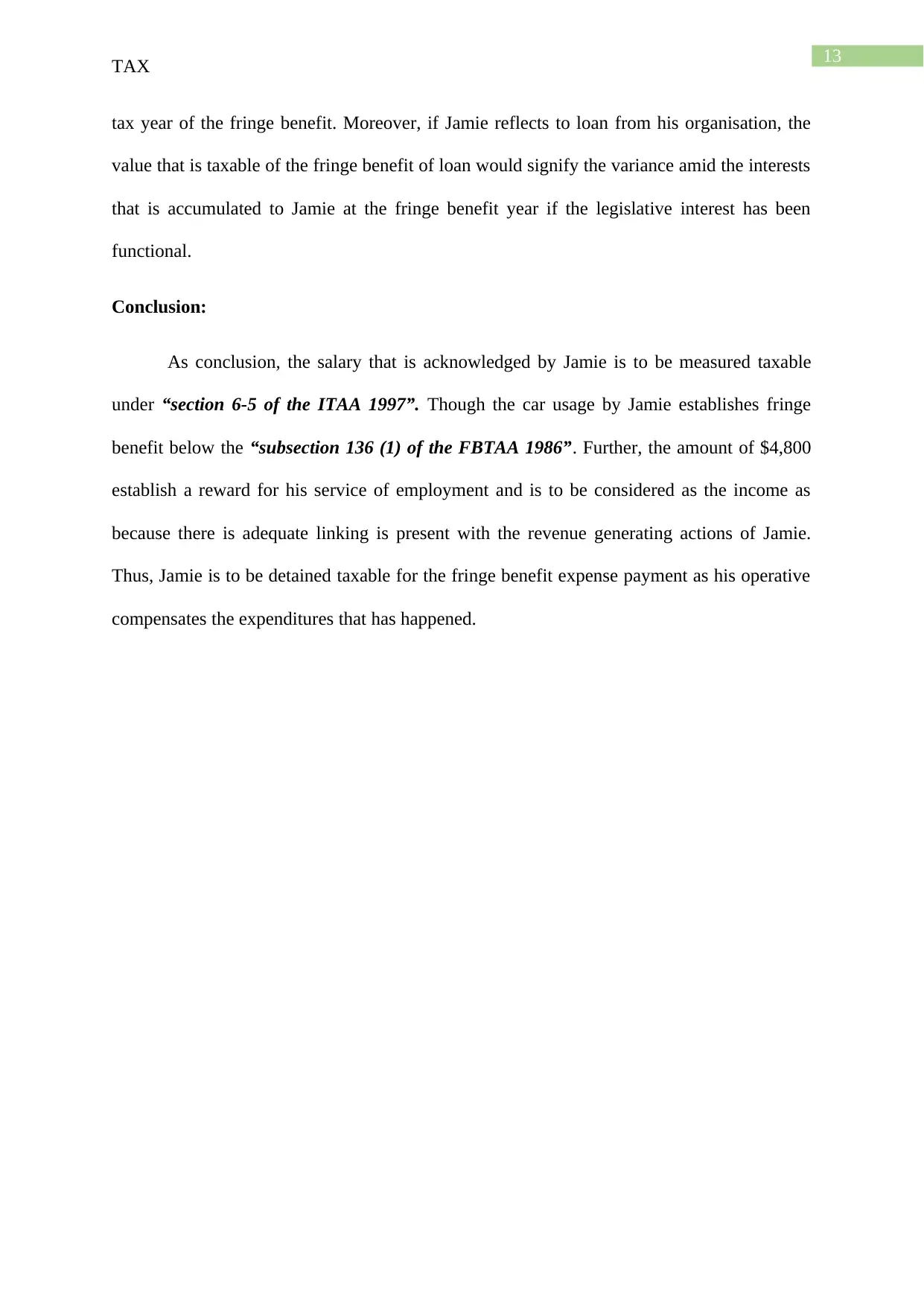
13
TAX
tax year of the fringe benefit. Moreover, if Jamie reflects to loan from his organisation, the
value that is taxable of the fringe benefit of loan would signify the variance amid the interests
that is accumulated to Jamie at the fringe benefit year if the legislative interest has been
functional.
Conclusion:
As conclusion, the salary that is acknowledged by Jamie is to be measured taxable
under “section 6-5 of the ITAA 1997”. Though the car usage by Jamie establishes fringe
benefit below the “subsection 136 (1) of the FBTAA 1986”. Further, the amount of $4,800
establish a reward for his service of employment and is to be considered as the income as
because there is adequate linking is present with the revenue generating actions of Jamie.
Thus, Jamie is to be detained taxable for the fringe benefit expense payment as his operative
compensates the expenditures that has happened.
TAX
tax year of the fringe benefit. Moreover, if Jamie reflects to loan from his organisation, the
value that is taxable of the fringe benefit of loan would signify the variance amid the interests
that is accumulated to Jamie at the fringe benefit year if the legislative interest has been
functional.
Conclusion:
As conclusion, the salary that is acknowledged by Jamie is to be measured taxable
under “section 6-5 of the ITAA 1997”. Though the car usage by Jamie establishes fringe
benefit below the “subsection 136 (1) of the FBTAA 1986”. Further, the amount of $4,800
establish a reward for his service of employment and is to be considered as the income as
because there is adequate linking is present with the revenue generating actions of Jamie.
Thus, Jamie is to be detained taxable for the fringe benefit expense payment as his operative
compensates the expenditures that has happened.
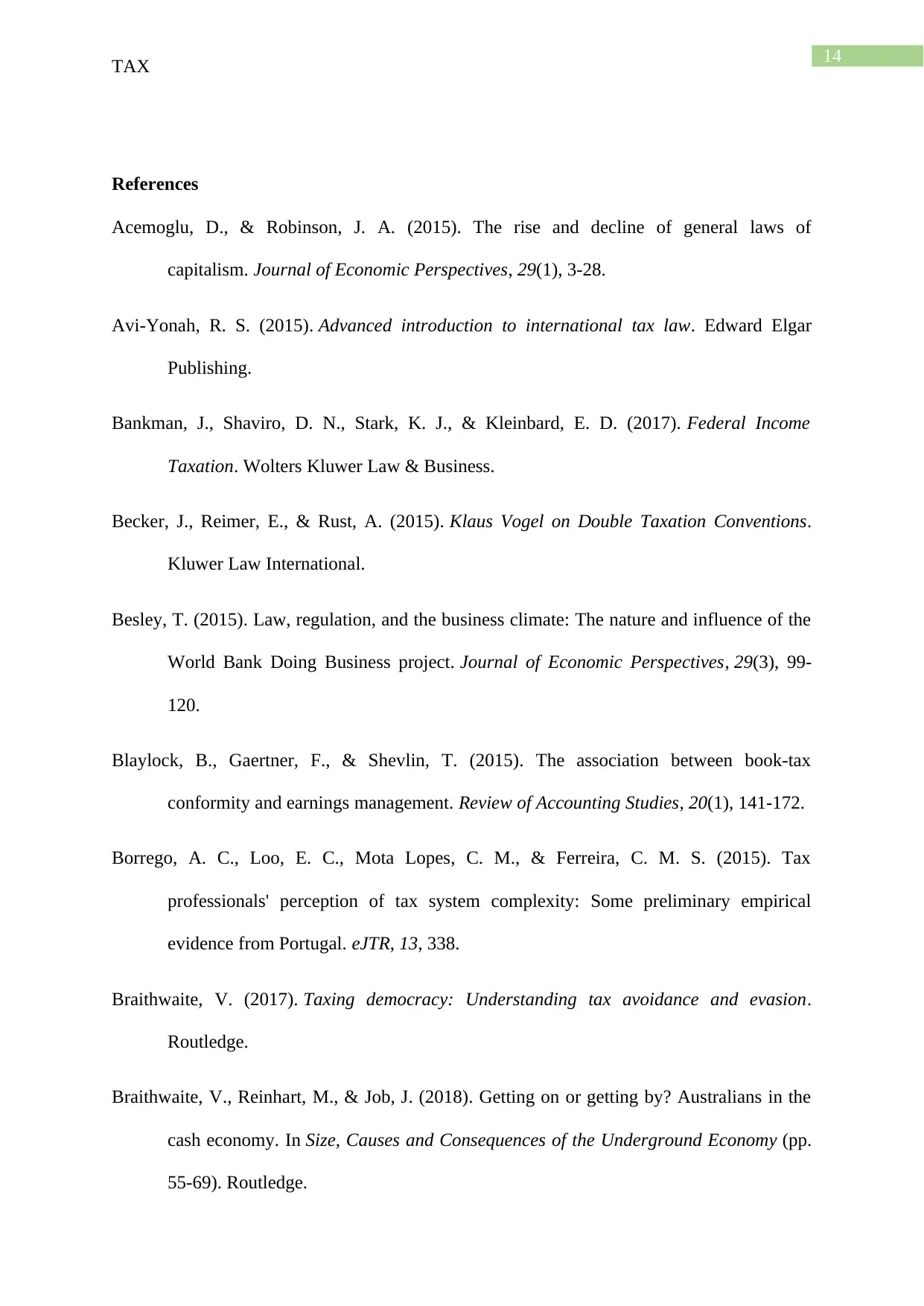
14
TAX
References
Acemoglu, D., & Robinson, J. A. (2015). The rise and decline of general laws of
capitalism. Journal of Economic Perspectives, 29(1), 3-28.
Avi-Yonah, R. S. (2015). Advanced introduction to international tax law. Edward Elgar
Publishing.
Bankman, J., Shaviro, D. N., Stark, K. J., & Kleinbard, E. D. (2017). Federal Income
Taxation. Wolters Kluwer Law & Business.
Becker, J., Reimer, E., & Rust, A. (2015). Klaus Vogel on Double Taxation Conventions.
Kluwer Law International.
Besley, T. (2015). Law, regulation, and the business climate: The nature and influence of the
World Bank Doing Business project. Journal of Economic Perspectives, 29(3), 99-
120.
Blaylock, B., Gaertner, F., & Shevlin, T. (2015). The association between book-tax
conformity and earnings management. Review of Accounting Studies, 20(1), 141-172.
Borrego, A. C., Loo, E. C., Mota Lopes, C. M., & Ferreira, C. M. S. (2015). Tax
professionals' perception of tax system complexity: Some preliminary empirical
evidence from Portugal. eJTR, 13, 338.
Braithwaite, V. (2017). Taxing democracy: Understanding tax avoidance and evasion.
Routledge.
Braithwaite, V., Reinhart, M., & Job, J. (2018). Getting on or getting by? Australians in the
cash economy. In Size, Causes and Consequences of the Underground Economy (pp.
55-69). Routledge.
TAX
References
Acemoglu, D., & Robinson, J. A. (2015). The rise and decline of general laws of
capitalism. Journal of Economic Perspectives, 29(1), 3-28.
Avi-Yonah, R. S. (2015). Advanced introduction to international tax law. Edward Elgar
Publishing.
Bankman, J., Shaviro, D. N., Stark, K. J., & Kleinbard, E. D. (2017). Federal Income
Taxation. Wolters Kluwer Law & Business.
Becker, J., Reimer, E., & Rust, A. (2015). Klaus Vogel on Double Taxation Conventions.
Kluwer Law International.
Besley, T. (2015). Law, regulation, and the business climate: The nature and influence of the
World Bank Doing Business project. Journal of Economic Perspectives, 29(3), 99-
120.
Blaylock, B., Gaertner, F., & Shevlin, T. (2015). The association between book-tax
conformity and earnings management. Review of Accounting Studies, 20(1), 141-172.
Borrego, A. C., Loo, E. C., Mota Lopes, C. M., & Ferreira, C. M. S. (2015). Tax
professionals' perception of tax system complexity: Some preliminary empirical
evidence from Portugal. eJTR, 13, 338.
Braithwaite, V. (2017). Taxing democracy: Understanding tax avoidance and evasion.
Routledge.
Braithwaite, V., Reinhart, M., & Job, J. (2018). Getting on or getting by? Australians in the
cash economy. In Size, Causes and Consequences of the Underground Economy (pp.
55-69). Routledge.
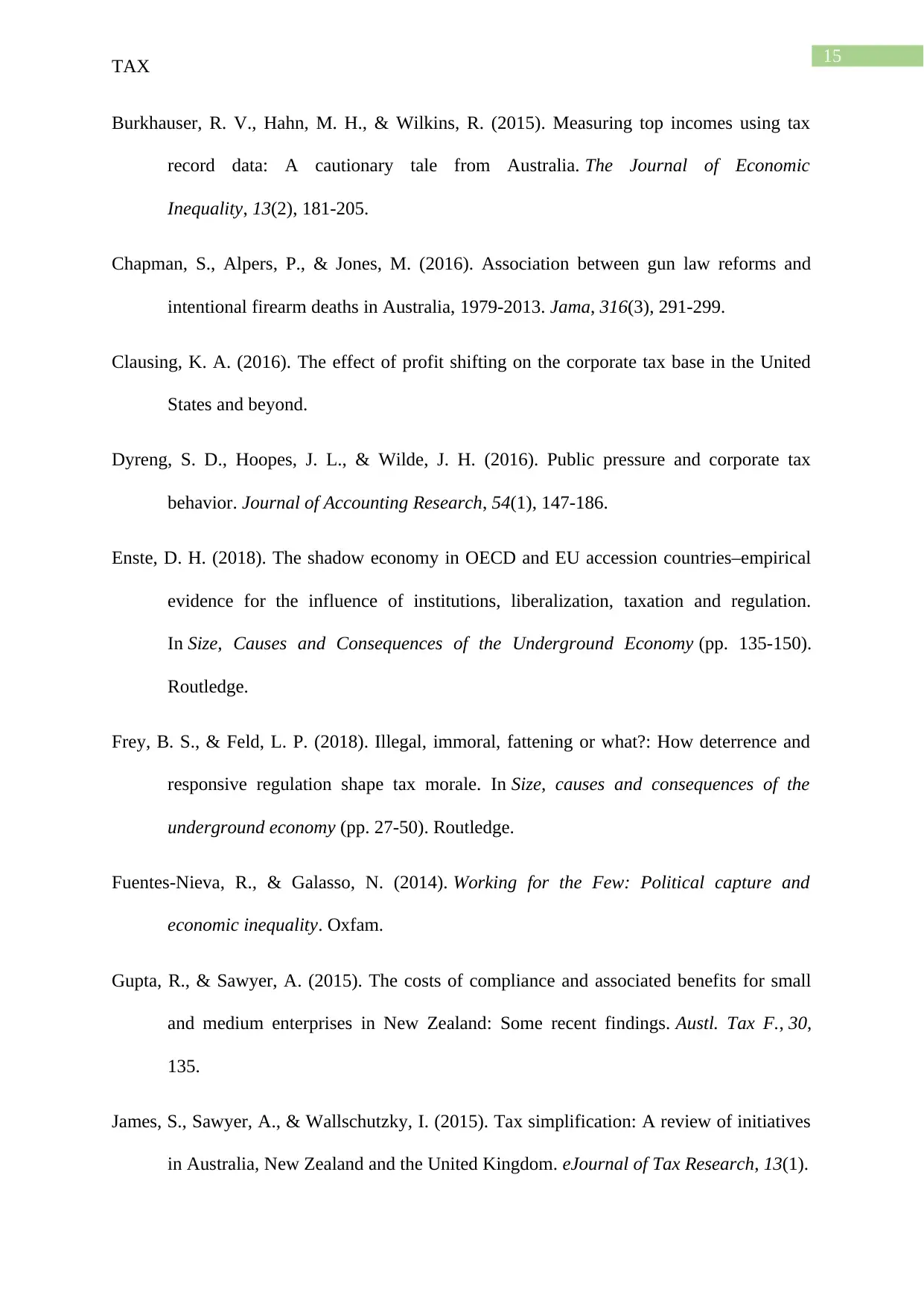
15
TAX
Burkhauser, R. V., Hahn, M. H., & Wilkins, R. (2015). Measuring top incomes using tax
record data: A cautionary tale from Australia. The Journal of Economic
Inequality, 13(2), 181-205.
Chapman, S., Alpers, P., & Jones, M. (2016). Association between gun law reforms and
intentional firearm deaths in Australia, 1979-2013. Jama, 316(3), 291-299.
Clausing, K. A. (2016). The effect of profit shifting on the corporate tax base in the United
States and beyond.
Dyreng, S. D., Hoopes, J. L., & Wilde, J. H. (2016). Public pressure and corporate tax
behavior. Journal of Accounting Research, 54(1), 147-186.
Enste, D. H. (2018). The shadow economy in OECD and EU accession countries–empirical
evidence for the influence of institutions, liberalization, taxation and regulation.
In Size, Causes and Consequences of the Underground Economy (pp. 135-150).
Routledge.
Frey, B. S., & Feld, L. P. (2018). Illegal, immoral, fattening or what?: How deterrence and
responsive regulation shape tax morale. In Size, causes and consequences of the
underground economy (pp. 27-50). Routledge.
Fuentes-Nieva, R., & Galasso, N. (2014). Working for the Few: Political capture and
economic inequality. Oxfam.
Gupta, R., & Sawyer, A. (2015). The costs of compliance and associated benefits for small
and medium enterprises in New Zealand: Some recent findings. Austl. Tax F., 30,
135.
James, S., Sawyer, A., & Wallschutzky, I. (2015). Tax simplification: A review of initiatives
in Australia, New Zealand and the United Kingdom. eJournal of Tax Research, 13(1).
TAX
Burkhauser, R. V., Hahn, M. H., & Wilkins, R. (2015). Measuring top incomes using tax
record data: A cautionary tale from Australia. The Journal of Economic
Inequality, 13(2), 181-205.
Chapman, S., Alpers, P., & Jones, M. (2016). Association between gun law reforms and
intentional firearm deaths in Australia, 1979-2013. Jama, 316(3), 291-299.
Clausing, K. A. (2016). The effect of profit shifting on the corporate tax base in the United
States and beyond.
Dyreng, S. D., Hoopes, J. L., & Wilde, J. H. (2016). Public pressure and corporate tax
behavior. Journal of Accounting Research, 54(1), 147-186.
Enste, D. H. (2018). The shadow economy in OECD and EU accession countries–empirical
evidence for the influence of institutions, liberalization, taxation and regulation.
In Size, Causes and Consequences of the Underground Economy (pp. 135-150).
Routledge.
Frey, B. S., & Feld, L. P. (2018). Illegal, immoral, fattening or what?: How deterrence and
responsive regulation shape tax morale. In Size, causes and consequences of the
underground economy (pp. 27-50). Routledge.
Fuentes-Nieva, R., & Galasso, N. (2014). Working for the Few: Political capture and
economic inequality. Oxfam.
Gupta, R., & Sawyer, A. (2015). The costs of compliance and associated benefits for small
and medium enterprises in New Zealand: Some recent findings. Austl. Tax F., 30,
135.
James, S., Sawyer, A., & Wallschutzky, I. (2015). Tax simplification: A review of initiatives
in Australia, New Zealand and the United Kingdom. eJournal of Tax Research, 13(1).
Secure Best Marks with AI Grader
Need help grading? Try our AI Grader for instant feedback on your assignments.
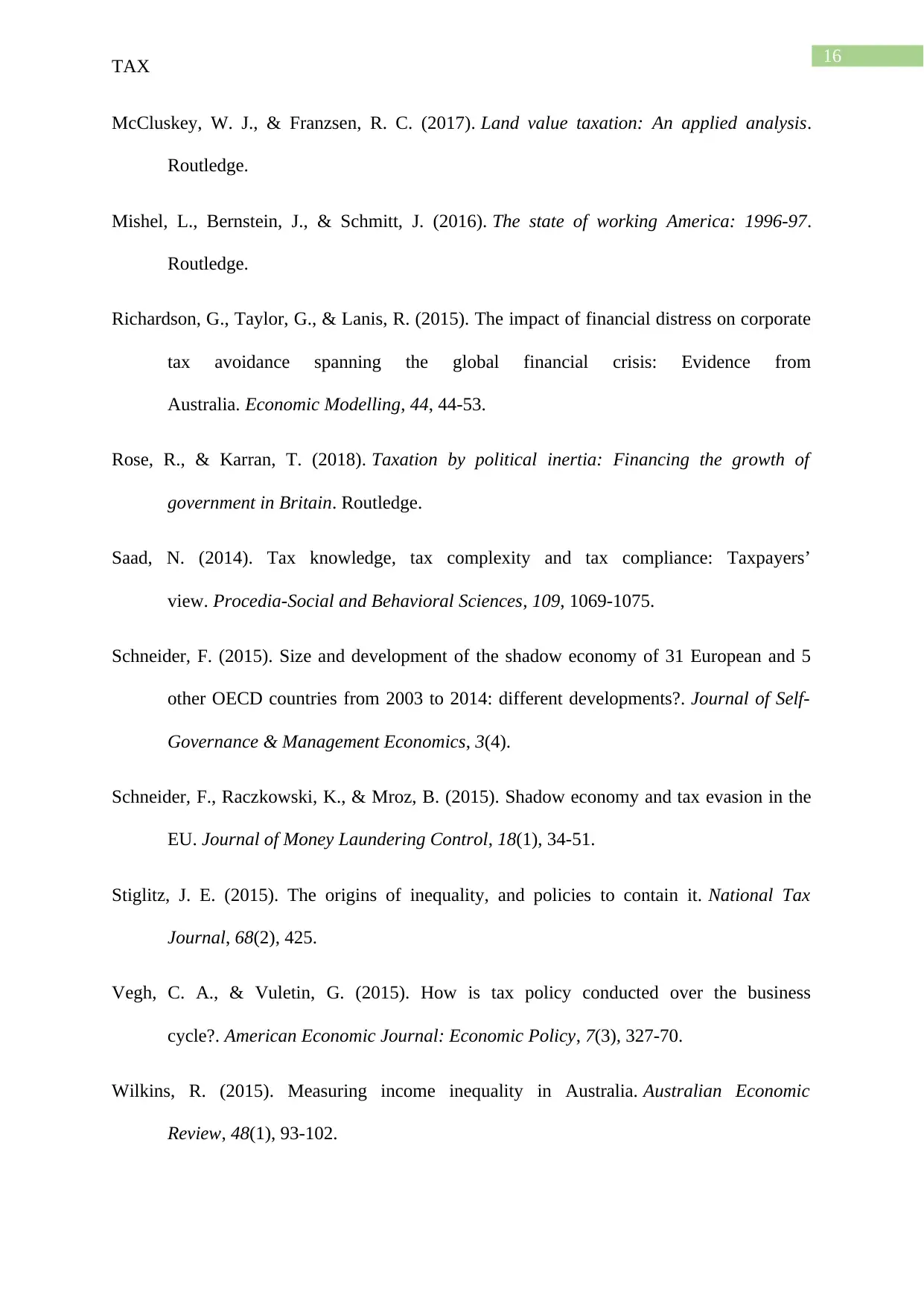
16
TAX
McCluskey, W. J., & Franzsen, R. C. (2017). Land value taxation: An applied analysis.
Routledge.
Mishel, L., Bernstein, J., & Schmitt, J. (2016). The state of working America: 1996-97.
Routledge.
Richardson, G., Taylor, G., & Lanis, R. (2015). The impact of financial distress on corporate
tax avoidance spanning the global financial crisis: Evidence from
Australia. Economic Modelling, 44, 44-53.
Rose, R., & Karran, T. (2018). Taxation by political inertia: Financing the growth of
government in Britain. Routledge.
Saad, N. (2014). Tax knowledge, tax complexity and tax compliance: Taxpayers’
view. Procedia-Social and Behavioral Sciences, 109, 1069-1075.
Schneider, F. (2015). Size and development of the shadow economy of 31 European and 5
other OECD countries from 2003 to 2014: different developments?. Journal of Self-
Governance & Management Economics, 3(4).
Schneider, F., Raczkowski, K., & Mroz, B. (2015). Shadow economy and tax evasion in the
EU. Journal of Money Laundering Control, 18(1), 34-51.
Stiglitz, J. E. (2015). The origins of inequality, and policies to contain it. National Tax
Journal, 68(2), 425.
Vegh, C. A., & Vuletin, G. (2015). How is tax policy conducted over the business
cycle?. American Economic Journal: Economic Policy, 7(3), 327-70.
Wilkins, R. (2015). Measuring income inequality in Australia. Australian Economic
Review, 48(1), 93-102.
TAX
McCluskey, W. J., & Franzsen, R. C. (2017). Land value taxation: An applied analysis.
Routledge.
Mishel, L., Bernstein, J., & Schmitt, J. (2016). The state of working America: 1996-97.
Routledge.
Richardson, G., Taylor, G., & Lanis, R. (2015). The impact of financial distress on corporate
tax avoidance spanning the global financial crisis: Evidence from
Australia. Economic Modelling, 44, 44-53.
Rose, R., & Karran, T. (2018). Taxation by political inertia: Financing the growth of
government in Britain. Routledge.
Saad, N. (2014). Tax knowledge, tax complexity and tax compliance: Taxpayers’
view. Procedia-Social and Behavioral Sciences, 109, 1069-1075.
Schneider, F. (2015). Size and development of the shadow economy of 31 European and 5
other OECD countries from 2003 to 2014: different developments?. Journal of Self-
Governance & Management Economics, 3(4).
Schneider, F., Raczkowski, K., & Mroz, B. (2015). Shadow economy and tax evasion in the
EU. Journal of Money Laundering Control, 18(1), 34-51.
Stiglitz, J. E. (2015). The origins of inequality, and policies to contain it. National Tax
Journal, 68(2), 425.
Vegh, C. A., & Vuletin, G. (2015). How is tax policy conducted over the business
cycle?. American Economic Journal: Economic Policy, 7(3), 327-70.
Wilkins, R. (2015). Measuring income inequality in Australia. Australian Economic
Review, 48(1), 93-102.

17
TAX
TAX
1 out of 18
Related Documents
Your All-in-One AI-Powered Toolkit for Academic Success.
+13062052269
info@desklib.com
Available 24*7 on WhatsApp / Email
![[object Object]](/_next/static/media/star-bottom.7253800d.svg)
Unlock your academic potential
© 2024 | Zucol Services PVT LTD | All rights reserved.



